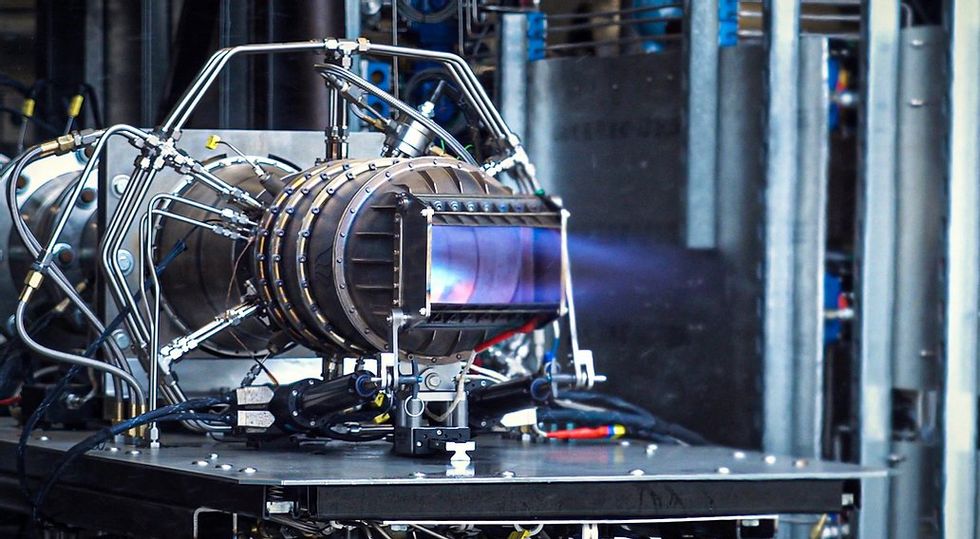Post by hunter on Aug 8, 2020 5:00:50 GMT
The Engine That Will Make Air Force One Hypersonic
Imagine if POTUS could fly from coast to coast in under an hour.
BY KYLE MIZOKAMI

The U.S. Air Force is funding an aviation startup working on a combined cycle engine.
Hermeus’s combined cycle engine can work like a regular turbofan or ramjet engine, reaching a speed of Mach 5.
The Air Force thinks the best application for the engine, oddly enough, is a future Air Force One.
Hermeus, a Georgia-based aviation startup, has announced a contract with the U.S. Air Force to develop its idea for a hypersonic aircraft engine. The Air Force department funding the project is the Presidential and Executive Airlift Directorate, the team that manages Air Force One. A Mach 5 aircraft could allow the president to fly from New York to London in 90 minutes, instead of the 7 hours it takes today.
The Air Force made the investment after Hermeus demonstrated its Mach 5 engine, developed in just 9 months, back in February. The engine is a combined cycle turbofan design that fuses both a normal turbofan engine and ramjet into a single engine. A normal turbofan engine sucks in air from the front and pushes it, along with exhaust gases, out the rear to generate thrust. This generates enough thrust to drive an aircraft at subsonic speeds.
A ramjet engine, meanwhile, is specifically designed to “ram” greater amounts of air into the engine using the forward speed of the aircraft, allowing for greater thrust. A major problem is that ramjets don’t work at subsonic speeds, so most designs envision a separate engine or rocket booster as a first stage. This adds complexity and cost to any ramjet transportation project.
But an aircraft equipped with a combined cycle engine, on the other hand, can take off like a regular airplane from regular airports with the engine in subsonic turbofan mode. Once the aircraft is airborne, it could switch to ramjet mode, then back to turbofan mode to land. One combined cycle engine can work in either mode, negating the need for a separate engine or rocket booster.

Hermeus’s combined cycle engine during testng.
Then there's the matter of a ramjet's air temperature. At high supersonic and low subsonic speeds, the air ingested by an engine gradually increases in temperature, and this hot air makes a ramjet engine less efficient. In its press release, Hermeus seems to indicate it’s solved this problem with a pre-cooler that chills the air before it enters the engine combustion chamber.
The company also claims it was able to achieve speeds faster than the famous SR-71 strategic reconnaissance aircraft with nothing more than a company modified off the shelf engine.
Imagine if POTUS could fly from coast to coast in under an hour.
BY KYLE MIZOKAMI

hermeus, air force one
Hermeus’s combined cycle engine can work like a regular turbofan or ramjet engine, reaching a speed of Mach 5.
The Air Force thinks the best application for the engine, oddly enough, is a future Air Force One.
Hermeus, a Georgia-based aviation startup, has announced a contract with the U.S. Air Force to develop its idea for a hypersonic aircraft engine. The Air Force department funding the project is the Presidential and Executive Airlift Directorate, the team that manages Air Force One. A Mach 5 aircraft could allow the president to fly from New York to London in 90 minutes, instead of the 7 hours it takes today.
The Air Force made the investment after Hermeus demonstrated its Mach 5 engine, developed in just 9 months, back in February. The engine is a combined cycle turbofan design that fuses both a normal turbofan engine and ramjet into a single engine. A normal turbofan engine sucks in air from the front and pushes it, along with exhaust gases, out the rear to generate thrust. This generates enough thrust to drive an aircraft at subsonic speeds.
A ramjet engine, meanwhile, is specifically designed to “ram” greater amounts of air into the engine using the forward speed of the aircraft, allowing for greater thrust. A major problem is that ramjets don’t work at subsonic speeds, so most designs envision a separate engine or rocket booster as a first stage. This adds complexity and cost to any ramjet transportation project.
But an aircraft equipped with a combined cycle engine, on the other hand, can take off like a regular airplane from regular airports with the engine in subsonic turbofan mode. Once the aircraft is airborne, it could switch to ramjet mode, then back to turbofan mode to land. One combined cycle engine can work in either mode, negating the need for a separate engine or rocket booster.

Hermeus’s combined cycle engine during testng.
Then there's the matter of a ramjet's air temperature. At high supersonic and low subsonic speeds, the air ingested by an engine gradually increases in temperature, and this hot air makes a ramjet engine less efficient. In its press release, Hermeus seems to indicate it’s solved this problem with a pre-cooler that chills the air before it enters the engine combustion chamber.
The company also claims it was able to achieve speeds faster than the famous SR-71 strategic reconnaissance aircraft with nothing more than a company modified off the shelf engine.











